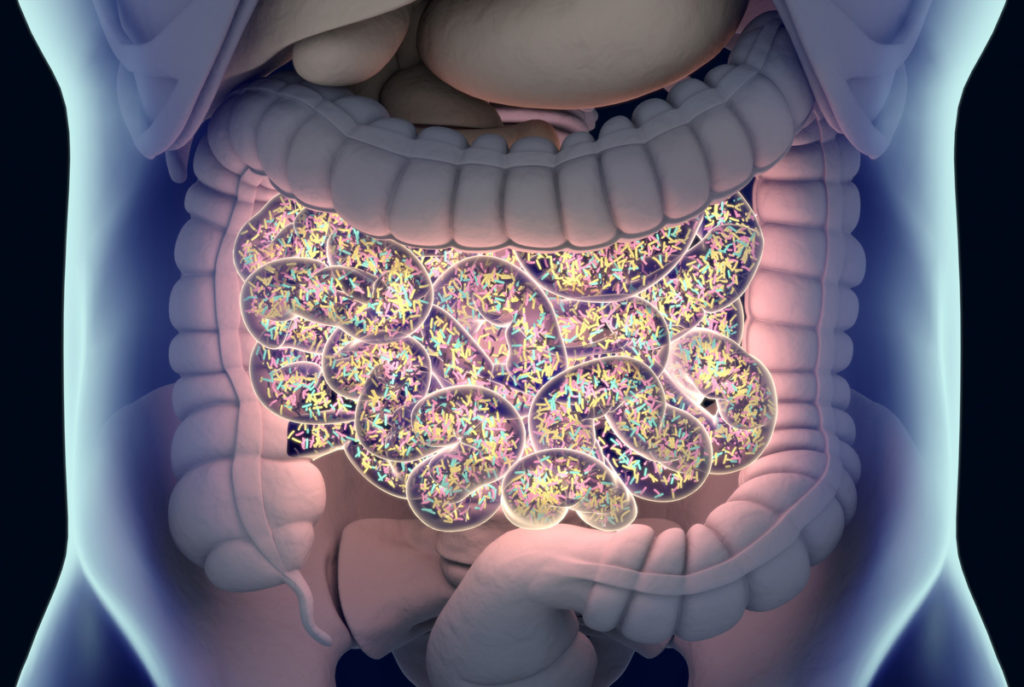The human microbiome is fascinating! There has been a HUGE paradigm switch over the past couple of years, as we are beginning to realize just how vital our diverse colonies of microbes are for our bodies. We went from fearing ALL bacteria, to learning how much we need beneficial bacteria to thrive and survive. Let’s not go back to fearing all bacteria, and learn how our microbiome is there to protect us, as the gatekeeper to our health.

Our body holds more than 100 trillion bacteria all over our skin, all over our body, in our mouths, ears, nose, armpits, and throughout our intestines. They live in diverse bacterial communities collectively known as (or the new trendy term) “The Human Microbiome.”
What exactly does the microbiome do for us? These tiny buggars communicate with each other and can synthesize vitamins and minerals, act as a “soldier” or “gatekeeper” in our gut to help keep pathogens out, boost our immune system, help us to digest our food, helps with our mood (some essential brain chemicals like serotonin are actually synthesized mainly in the gut), helps prevent GI disorders like IBS and Crohn’s Disease, and—science is continuously finding more roles these beneficial bacteria play. The health of the microbiome has been linked to obesity, type 2 diabetes, and even heart disease. Our bugs are pretty important, and we need to take care of them!
Here are five facts you might not have known about the fantastic microbiome:
1. Our microbiome can weigh as much as an organ.
Your total microbes weigh approximately 3 pounds but can weigh up to as much as 5 pounds…5 pounds of microscopic bacteria that are working together in large communities to take care of YOU!
2. Our microbes need to eat to survive too.
This is where the concept of “prebiotics” comes into play. We take probiotics to replace beneficial bacteria; we take prebiotics to essentially feed that bacteria so it can survive, thrive, and colonize. Prebiotics are in fiber-rich foods-such as plantains and bananas, as well as asparagus, garlic, and onions. Prebiotic fiber is not digested but rather works symbiotically with probiotics to increase the population of good bacteria. One form of prebiotics is resistant starch. Resistant starches are starches that we do not digest, but rather are utilized in the GI tract to feed bacteria and possess many other health benefits. Resistant starch forms in foods after cooking and cooling. One example is using potatoes-cooking, and cooling them forms resistant starch. This cooking and cooling process works with white rice as well.
3. The way your baby enters the world has a permanent effect on their microbiome.
Scientists are finding that pregnant women pass significant microbes onto their infant while the infant passes through the birthing canal. One study examined the changes in vaginal microbiome during pregnancy. As early as the first trimester, the diversity of vaginal bacteria changes immensely. Species that were once quite abundant dissipate and new species of bacteria arrive. One species that forms in the vagina, Lactobacillus johnsonii, is usually found only in the gut, where it produces enzymes that digest milk. Changing conditions in the vagina during pregnancy encourage this strain of bacteria to grow.
During delivery, the baby will be covered by Lactobacillus johnsonii and even ingest some of it. This “bacteria bath” prepares the infant to be able to digest breastmilk. When passing through the birthing canal, the baby swallows and is bathed in bacteria and even some feces. Babies are born down by the anus for a reason! There are colonies of beneficial bacteria down there. Babies born via cesarian are more likely to struggle with health problems like asthma, allergies, eczema, type 1 diabetes, and celiac disease.
Some cesarian sections are necessary.
What can a parent do to ensure her baby gets bathed with this beneficial bacteria? One way to pass beneficial bacteria on to a cesarian delivered baby is via vaginal seeding, a way to bath the baby with bacteria from the vagina upon delivery. Skin to skin contact with a parent vs. being swaddled continues to pass bacteria to the baby. Breastfeeding is also crucial to continue to inoculate the baby with beneficial bacteria.
4. Let your kiddos get their hands dirty and even taste a little—hear me out.
There are beneficial bacteria in the soil. Babies put everything in their mouths for a reason, more than just exploration. Many cultures actually eat dirt, and they perceive eating dirt as an everyday thing. It helps strengthen the immune system and build up our resistance to pathogenic bacteria.
I’m not advocating you feed your family dirt patties, but—dirt is associated with protection from chemicals, parasites, bad bacteria, and toxins. So don’t fear dirt so much! Go ahead and let your kids dig, play, and get dirty.
5. People who struggle with their weight tend to have a makeup of bacteria in their intestine that is different from that of people who are of normal weight.
Recent evidence suggests that there is a link between metabolic diseases such as obesity and Type 2 diabetes and the bacterial populations in the gut. The proportion of two major groups of bacteria in the large intestine, Bacteroidetes, and Firmicutes, may play a large role. In this study comparing the distal gut microbiota of obese mice and their lean counterparts, the researchers found that the obese microbiome has an increased capacity to harvest energy from the diet. Obesity was associated with changes in the abundance of Bacteroides and firmicutes. They also found that the trait was transmissible:
“colonization of germ-free mice with an ‘obese microbiota’ results in a significantly greater increase in total body fat than colonization with a ‘lean microbiota.’ These results identify the gut microbiota as an additional contributing factor to the pathophysiology of obesity.”
The human gut microbiota is an extraordinarily complex and vital system that affects human health. Up until recent times, we have disregarded its existence and treated all bacteria as pathogenic. We need to “water the flowers” and take care of our GOOD microbiome, so these trillions of bugs can, in turn, take care of us!
Have you had your microbes tested? (not receiving payment of any kind, just love them)
Interested in seeing your personal gut- bacteria composition as well as receive personalized recommendations for probiotics, and what foods would help your gut thrive best? I just tried Thryve, and I was fascinated by my own results! Apparently, my gut is like an amazon rainforest with diversity, so I was happy to hear all the work I have been doing towards a healthy gut is paying off!
This at-home test analyzes your poop to target the good & bad bacteria in your gut to treat the root cause of your symptoms with guidance on what foods are best for you and which ones to avoid.
Results they send you include:
- Personalized Gut Health Report (loved geeking out on this)
- Personalized Nutrition Plan
- Personalized Recommended Probiotics





1 Comment
Leave your reply.